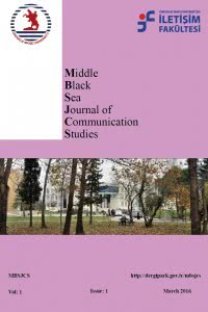Kişisel ve Bağımsız Film Yapımı: Amerika Amerika
Bağımsız Film Yapımı, Kişisel Film, Elia Kazan, Amerika Amerika, Film Çalışmaları
Personal And Independent Filmmaking: Elia Kazan’s America America
___
- Andrew, J. D. (1976). The Major Film Theories. Oxford University Press.
- Ciment, M. (1973). Kazan on Kazan. C. Williams ( Ed.). London: Secker & Warburg.
- Cornfield, R. (Ed.). (2009). Kazan on Directing. Vintage Books.
- Dombrowski, L. (Ed.). (2011). Kazan Revisited. Connecticut: Wesleyan University Press.
- Jones, D. R. (1986). Great Directors at Work. University of California Press.
- Kracauer, S. (1960). Theory of Film. Oxford University Press.
- Lev, P. (2003). History of the American Cinema: Transforming the Screen 1950 - 1959. C. Harpole, (Ed.). Charles Scribner’s Sons.
- MacCabe, C. (1976). Theory and Film: Principles of Realism and Pleasure, Screen, 17(3), 7–28.
- Mann, D. (2008). Hollywood Independents: The Postwar Talent Takeover. University of Minnesota Press.
- Michaels, L. (1985). Elia Kazan: A Retrospective, Film Criticism, 10(1), 32–46.
- Neve, B. (2009). Elia Kazan: The Cinema of an American Outsider. I.B Tauris.
- Nichols, Bill (1991). Representing Reality: Issues and Concepts in Documentary. Indiana University Press.
- Perkins, V. F. (1972). Film as Film. London: Penguin Books.
- Schickel, R. (2006). Elia Kazan: A Biography. Harper Perennial.
- Sklar, R. (2001). Film: An International History of the Medium (2nd ed.). Prentice Hall.
- Stam, R. (2000). Film Theory: An Introduction. Blackwell Publishing.
- Stam, R. & Miller, T. (Eds.). (1999). A Companion to Film Theory. Blackwell Publishing.
- Thomson, D. (2014). The New Biographical Dictionary of Film (6th ed.). Alfred A. Knopf.
- Turner, G. (Ed.). (2002). The Film Cultures Reader. Routledge.
- Williams, C. (Ed.). (1980). Realism and the Cinema. Routledge.
- Young, J. (1999). Kazan: The Master Director Discusses His Films (1st ed.). Newmarket Press New York.
- FILMS Rossellini, Roberto (Director). (1946). Paisà. Organizzazione Film Internazionali (OFI).
- Kazan, Elia (Director). (1950). Panic in the Streets. Twentieth Century Fox.
- Kazan, Elia (Director). (1951). A Streetcar Named Desire. Charles K. Feldman Group, Warner Bros.
- Kazan, Elia (Director). (1954). On the Waterfront. Horizon Pictures.
- Kazan, Elia (Director). (1955). East of Eden. Warner Bros.
- Kazan, Elia (Director). (1960). Wild River. Twentieth Century Fox.
- Kazan, Elia (Director). (1963). America America. Athena Enterprises, Warner Bros.
- Kazan, Elia (Director). (1972). The Arrangement. Athena Productions.
- Kazan, Elia (Director). (1976). The Last Tycoon. Academy Pictures Corporation.
- Yayın Aralığı: Yılda 2 Sayı
- Başlangıç: 2016
- Yayıncı: Ondokuz Mayıs Üniversitesi
12 Mart 1971 Muhtırası'nın Dönemin Köşe Yazılarına Yansımaları
Kişisel ve Bağımsız Film Yapımı: Amerika Amerika
Deleuzeyen Perspektifle Dalgaları Aşmak Filmi
Televizyon Yayıncılığında Dijitalleşme ile Değişen Yayıncılık
Hilal Gamze ÇAKIR, Nursel BOLAT
Medya Çalışmaları Bağlamında Dönüşen Hikâye Anlatıcılığı: Transmedya Hikâye Anlatısı
